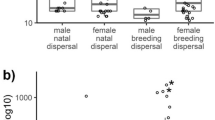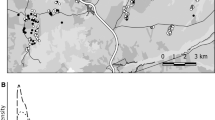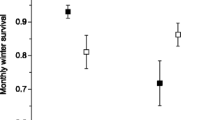Abstract
Sex- and age-dependence in recruitment and dispersal are often explained by costs arising from competition for holding a breeding territory over the years—a typical feature of species living in stable habitats. For instance, long-lived birds with male territoriality often exhibit large variation in recruitment age and higher dispersal in females and young individuals. As a corollary, we expected that species with ephemeral habitat suitability, and hence nomadic breeding, would show weak age- and sex-dependence in dispersal and low variation in recruitment age, because territory ownership is not maintained over the years. In addition, the higher cost of reproduction in females might not be (over)compensated for by costs of territoriality in males. Accordingly, females would recruit later than males. We explored these variations using multievent capture–recapture models over 13 years, 3479 (2392 sexed) slender-billed gulls (Chroicocephalus genei) and 45 colony sites along the French Mediterranean coast. As expected, variability in recruitment age was low with males recruiting earlier than females. Nonetheless, dispersal in and out of the study area decreased with age and was slightly higher in males than in females. Decreased dispersal with age might result from foraging benefits associated with increased spatial familiarity. Higher dispersal in males might be explained by a male-biased sex ratio or higher philopatry benefits in females (arising from their higher cost of reproduction). Sex- and age-dependent dispersal and recruitment may thus occur in the absence of year-to-year breeding territory ownership, which stresses the importance of considering other processes in shaping recruitment and dispersal patterns.



Similar content being viewed by others
Change history
01 December 2017
Unfortunately, Table 1 was incorrectly.
References
Acker P, Besnard A, Monnat J-Y, Cam E (2017) Breeding habitat selection across spatial scales: is grass always greener on the other side? Ecol 98: 2684–2697
Arnold JM, Hatch JJ, Nisbet IC (2004) Seasonal declines in reproductive success of the common tern Sterna hirundo: timing or parental quality? J Avian Biol 35:33–45
Aubry LM, Cam E, Monnat J-Y (2009) Habitat selection, age-specific recruitment and reproductive success in a long-lived seabird. In: Thomson DL, Cooch EG, Conroy MJ (eds) Modeling demographic processes in marked populations. Springer, New York, pp 365–392
Béchet A, Rendón-Martos M, Rendón MA, Amat JA, Johnson A, Gauthier-Clerc M (2012) Global economy interacts with climate change to jeopardize species conservation: the case of the greater flamingo in the Mediterranean and West Africa. Envir Conser 39:1–3
Becker PH, Bradley JS (2007) The role of intrinsic factors for the recruitment process in long-lived birds. J Ornithol 148:377–384
Berglund A (1994) The operational sex ratio influences choosiness in a pipefish. Behav Ecol 5:254–258
Besnard A (2001) Evolution de l’élevage des poussins en crèche chez les laridés. PhD dissertation, Université de Montpellier 2, France
Besnard A, Gimenez O, Lebreton J-D (2002) A model for the evolution of crèching behaviour in gulls. Evol Ecol 16:489–503
Besnard A, Sadoul N, Lebreton J-D (2006) First quantitative comparison of aggression between crèching and non-crèching larid species. Waterbirds 29:481–488
Bonte D, Van Dyck H, Bullock JM, Coulon A, Delgado MM et al (2012) Costs of dispersal. Biol Rev 87:290–312
Bosman DS, Vercruijsse HJ, Stienen EW, Vincx M, Lens L (2013) Age of first breeding interacts with pre-and post-recruitment experience in shaping breeding phenology in a long-lived gull. PLoS ONE 8:e82093
Boulinier T, Danchin E (1997) The use of conspecific reproductive success for breeding patch selection in terrestrial migratory species. Evol Ecol 11:505–517
Boulinier T, Lemel J-Y (1996) Spatial and temporal variation of factors affecting breeding habitat quality in colonial birds: some consequences for dispersal and habitat selection. Acta Oecol 17:531–552
Bowler DE, Benton TG (2005) Causes and consequences of animal dispersal strategies: relating individual behaviour to spatial dynamics. Biol Rev 80:205–225
Bradshaw CJA, Hindell MA, Sumner MD, Michael KJ (2004) Loyalty pays: potential life history consequences of fidelity to marine foraging regions by southern elephant seals. Anim Behav 68:1349–1360
Breton AR, Nisbet ICT, Mostello CS, Hatch JJ (2014) Age-dependent breeding dispersal and adult survival within a metapopulation of common terns sterna hirundo. Ibis 156:534–547
Brunton DH (1997) Impacts of predators: center nests are less successful than edge nests in a large nesting colony of Least Terns. Condor 99:372–380
Burnham KP, Anderson DA (2002) Model selection and multimodel inference: a practical information-theoretic approach. Springer, New York
Cadiou B, Monnat J-Y, Danchin E (1994) Prospecting in the kittiwake, Rissa tridactyla: different behavioral patterns and the role of squatting in recruitment. Anim Behav 47:847–856
Cam E, Aubry L (2011) Early development, recruitment and life history trajectory in long-lived birds. J Ornithol 152:187–201
Charlesworth B (1994) Evolution in age-structured populations. Cambridge University Press, Cambridge
Choquet R, Lebreton J-D, Gimenez O, Reboulet AM, Pradel R (2009a) U-CARE: utilities for performing goodness of fit tests and manipulating capture-recapture data. Ecography 32:1071–1074
Choquet R, Rouan L, Pradel R (2009b) Program E-Surge: a software application for fitting multievent models. In: Thomson DL, Cooch EG, Conroy MJ (eds) Modeling demographic processes in marked populations. Springer, New York, pp 845–865
Clutton-Brock TH (1991) The evolution of parental care. Princeton University Press, Princeton
Congdon JD, Dunham AE, van Loben Sels RC (1993) Delayed sexual maturity and demographics of Blanding’s Turtles (Emydoidea blandingii): implications for conservation and management of long-lived organisms. Conserv Biol 7:826–833
Crawford RJM, Dyer BM, Brooke RK (1994) Breeding nomadism in southern African seabirds-constraints, causes and conservation. Ostrich 65:231–246
Crespin L, Harris MP, Lebreton JD, Frederiksen M, Wanless S (2006) Recruitment to a seabird population depends on environmental factors and on population size. J Anim Ecol 75:228–238
Danchin E, Monnat J-Y (1992) Population-dynamics modeling of two neighboring kittiwake rissa-tridactyla colonies. Ardea 80:170–180
Dean W (1997) The distribution and biology of nomadic birds in the Karoo, South Africa. J Biogeogr 24:769–779
del Hoyo J, Elliott A, Sargatal J (2014) Handbook of the birds of the world. Lynx, Barcelona
Desprez M, Harcourt R, Hindell MA, Cubaynes S, Gimenez O, McMahon CR (2014) Age-specific cost of first reproduction in female southern elephant seals. Biol Lett 10:20140264
Devlin CM (2006) Birds crossing borders: a population study of arctic terns (Sterna paradisaea). PhD dissertation, University of New Brunswick, USA
Devlin CM, Diamond AW, Kress SW et al (2008) Breeding dispersal and survival of Arctic Terns (Sterna Paradisaea) nesting in the Gulf of Maine. Auk 125:850–858
Doxa A, Besnard A, Bechet A, Pin C, Lebreton J-D, Sadoul N (2013) Inferring dispersal dynamics from local population demographic modelling: the case of the slender-billed gull in France. Anim Conserv 16:648–693
Ens BJ, Weissing FJ, Drent RH (1995) The despotic distribution and deferred maturity: two sides of the same coin. Am Nat 146:625–650
Erwin RM, Galli J, Burger J (1981) Colony site dynamics and habitat use in Atlantic coast seabirds. Auk 98:550–561
Evans JC, Votier SC, Dall SRX (2015) Information use in colonial living. Biol Rev 91:658–672
Fasola M, Canova L (1992) Nest habitat selection by eight synoptic species of Mediterranean Gulls and Terns. Colon Waterbirds 15:169–178
Fernández-Chacón A, Genovart M, Pradel R et al (2013) When to stay, when to disperse and where to go: survival and dispersal patterns in a spatially structured seabird population. Ecography 36:1117–1126
Forslund P, Pärt T (1995) Age and reproduction in birds—hypotheses and tests. Trends Ecol Evol 10:374–378
Francesiaz C, Farine D, Laforge C, Béchet A, Sadoul N, Besnard A (2017) Familiarity drives social philopatry in an obligate colonial breeder with weak interannual breeding-site fidelity. Anim Behav 124:125–133
Fransson T, Kolehmainen T, Kroon C, Jansson L, Wenninger T (2010) EURING list of longevity records for European birds. https://euring.org/data_and_codes/longevity.htm. Accessed 13 Oct 2017
Frederiksen M, Harris MP, Wanless S (2005) Inter-population variation in demographic parameters: a neglected subject? Oikos 111:209–214
Friedenberg NA (2003) Experimental evolution of dispersal in spatiotemporally variable microcosms. Ecol Lett 6:953–959
Gaillard J-M, Festa-Bianchet M, Yoccoz NG et al (2000) Temporal variation in fitness components and population dynamics of large herbivores. Annu Rev Ecol Evol Sys 31(1):367–393
Greenwood PJ (1980) Mating systems, philopatry and dispersal in birds and mammals. Anim Behav 28:1140–1162
Greenwood PJ, Harvey PH (1982) The natal and breeding dispersal of birds. Annu Rev Ecol Evol Syst 13:1–21
Griffiths R, Double MC, Orr K, Dawson RJG (1998) A DNA test to sex most birds. Mol Ecol 7:1071–1075
Grosbois, V (2001) La dispersion: trait d’histoire de vie et paramètre démographique: étude empirique dans une population de mouette rieuse. PhD dissertation, Université de Montpellier 2, France
Grosbois V, Tavecchia G (2003) Modeling dispersal with capture-recapture data: disentangling decisions of leaving and settlement. Ecology 84:1225–1236
Hamilton WD, May RM (1977) Dispersal in stable habitats. Nature 269:578–581
Jirotkul M (1999) Operational sex ratio influences female preference and male–male competition in guppies. Anim Behav 58:287–294
Johnson JB, Omland KS (2004) Model selection in ecology and evolution. Trends Ecol Evol 19:101–108
Kim S-Y, Velando A, Torres R, Drummond H (2011) Effects of recruiting age on senescence, lifespan and lifetime reproductive success in a long-lived seabird. Oecologia 166:615–626
Kokko H, Rankin DJ (2006) Lonely hearts or sex in the city? Density-dependent effects in mating systems. Philos Trans R Soc B 361:319–334
Kokko H, Harris MP, Wanless S (2004) Competition for breeding sites and site-dependent population regulation in a highly colonial seabird, the common guillemot Uria aalge. J Anim Ecol 73:367–376
Komers PE, Pélabon C, Stenström D (1997) Age at first reproduction in male fallow deer: age-specific versus dominance-specific behaviors. Behav Ecol 8:456–462
Lebreton JD, Hines JE, Pradel R, Nichols JD, Spendelow JA (2003) Estimation by capture-recapture of recruitment and dispersal over several sites. Oikos 101:253–264
Link WA, Cam E, Nichols JD, Cooch EG (2002) Of bugs and birds: Markov chain Monte Carlo for hierarchical modeling in wildlife research. J Wildl Manag 66:277–291
Lurz PWW, Garson PJ, Wauters LA (1997) Effects of temporal and spatial variation in habitat quality on red squirrel dispersal behaviour. Anim Behav 54:427–435
Martin JGA, Festa-Bianchet M (2012) Determinants and consequences of age of primiparity in bighorn ewes. Oikos 121:752–760
McNicholl MK (1975) Larid site tenacity and group adherence in relation to habitat. Auk 92:98–104
McPeek MA, Holt RD (1992) The evolution of dispersal in spatially and temporally varying environments. Am Nat 140:1010–1027
Michener GR, Locklear L (1990) Differential costs of reproductive effort for male and female richardson’s ground squirrels. Ecology 71:855–868
Mills JA (1973) The influence of age and pair-bond on the breeding biology of the red-billed gull Larus novaehollandiae scopulinus. J Anim Ecol 42:147–162
Mills JA, Yarrall JW, Mills DA (1996) Causes and consequences of mate fidelity in red-billed gulls. In: Black JM (ed) Partnerships in birds—the study of monogamy. Oxford University Press, Oxford, pp 118–137
Mills JA, Yarrall JW, Bradford-Grieve JM, Uddstrom MJ, Renwick JA, Merilä J (2008) The impact of climate fluctuation on food availability and reproductive performance of the planktivorous red-billed gull Larus novaehollandiae scopulinus. J Anim Ecol 77:1129–1142
Nisbet IC, Cam E (2002) Test for age-specificity in survival of the common tern. J Appl Stat 29:65–83
Oro D, Tavecchia G, Genovart M (2011) Comparing demographic parameters for philopatric and immigrant individuals in a long-lived bird adapted to unstable habitats. Oecologia 165:935–945
Palestis BG, Hines JE (2015) Adult survival and breeding dispersal of common terns (Sterna hirundo) in a declining population. Waterbirds 38:221–228
Perrin N, Mazalov V (2000) Local competition, inbreeding, and the evolution of sex-biased dispersal. Am Nat 155:116–127
Piper WH (2011) Making habitat selection more “familiar”: a review. Behav Ecol Sociobiol 65:1329–1351
Porter JM, Coulson JC (1987) Long-term changes in recruitment to the breeding group, and the quality of recruits at a kittiwake Rissa tridactyla colony. J Anim Ecol 56:675–689
Pradel R (2005) Multievent: an extension of multistate capture-recapture models to uncertain states. Biometrics 61:442–447
Pradel R, Gimenez O, Lebreton J-D (2005) Principles and interest of GOF tests for multistate capture–recapture models. Animal Biodivers Conserv 28:189–204
Prévot-Julliard A-C, Lebreton J-D, Pradel R (1998) Re-evaluation of adult survival of black-headed gulls (Larus ridibundus) in presence of recapture heterogeneity. Auk 115:85–95
Ratcliffe N, Newton S, Morrison P et al (2008) Adult survival and breeding dispersal of roseate terns within the northwest European metapopulation. Waterbirds 31:320–329
Sanz-Aguilar A, Tavecchia G, Afán I, Ramírez F, Doxa A, Bertolero A, Gutiérrez-Expósito C, Forero MG, Oro D (2014) Living on the edge: demography of the slender-billed gull in the western mediterranean. PLoS ONE 9:e92674
Schaub M, Gimenez O, Schmidt BR, Pradel R (2004) Estimating survival and temporary emigration in the multistate capture-recapture framework. Ecology 85:2107–2113
Stockley P, Bro-Jørgensen J (2011) Female competition and its evolutionary consequences in mammals. Biol Rev 86:341–366
Switzer PV (1993) Site fidelity in predictable and unpredictable habitats. Evol Ecol 7:533–555
Szostek KL, Schaub M, Becker PH (2014) Immigrants are attracted by local pre-breeders and recruits in a seabird colony. J Anim Ecol 83:1015–1024
Travis JMJ, Dytham C (1999) Habitat persistence, habitat availability and the evolution of dispersal. Proc R Soc B 266:723–728
Trochet A, Courtois EA, Stevens VM et al (2016) Evolution of sex-biased dispersal. Q Rev Biol 91:297–320
van de Pol M, Pen I, Heg D, Weissing FJ (2007) Variation in habitat choice and delayed reproduction: adaptive queuing strategies or individual quality differences? Am Nat 170:530–541
Vanpé C, Gaillard J-M, Morellet N et al (2009) Age-specific variation in male breeding success of a territorial ungulate species, the European roe deer. J Mammal 90:661–665
Wakefield ED, Cleasby IR, Bearhop S et al (2015) Long-term individual foraging site fidelity—why some gannets don’t change their spots. Ecology 96:3058–3074
Williams TD (2005) Mechanisms underlying the costs of egg production. Bioscience 55:39–48
Acknowledgements
We are grateful to the many volunteers, ringers, and students who assisted with captures and observations at the colonies, and in particular to Christophe Pin who has been instrumental in maintaining the ring-resighting effort on the long-term. We are also grateful to Roger Pradel for his useful advice about E-SURGE and multievent modelling. The monitoring of the slender-billed gull was funded by Tour du Valat, the non-profit organisation Les Amis du Marais du Vigueirat, and the MAVA foundation. This work was supported by the French Laboratory of Excellence project ‘TULIP’ (ANR-10-LABX-41; ANR-11-IDEX-0002-02).
Author information
Authors and Affiliations
Contributions
PA, CF, and A Besnard formulated the ideas; PA and CF performed the analyses and wrote the manuscript; NS conceived the monitoring study. NS and A Béchet were responsible for data collection; ASP performed genetic sexing; A Besnard, A Béchet, CML, and NS provided editorial advice.
Corresponding author
Additional information
Communicated by Hannu Pöysä.
The original version of this article was revised: Table 1 and the contribution statement was incorrectly published in the original version and corrected here.
Paul Acker and Charlotte Francesiaz have contributed equally to the work.
A correction to this article is available online at https://doi.org/10.1007/s00442-017-4001-6.
Electronic supplementary material
Below is the link to the electronic supplementary material.
Rights and permissions
About this article
Cite this article
Acker, P., Francesiaz, C., Béchet, A. et al. Insights on dispersal and recruitment paradigms: sex- and age-dependent variations in a nomadic breeder. Oecologia 186, 85–97 (2018). https://doi.org/10.1007/s00442-017-3972-7
Received:
Accepted:
Published:
Issue Date:
DOI: https://doi.org/10.1007/s00442-017-3972-7




